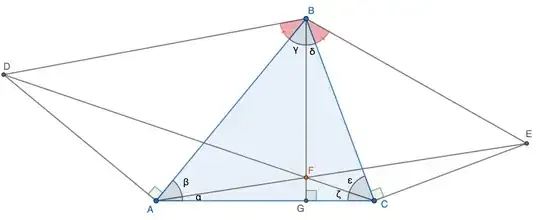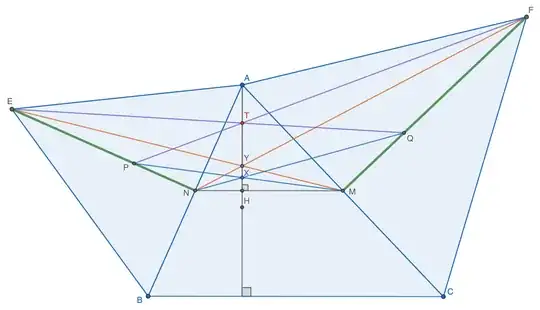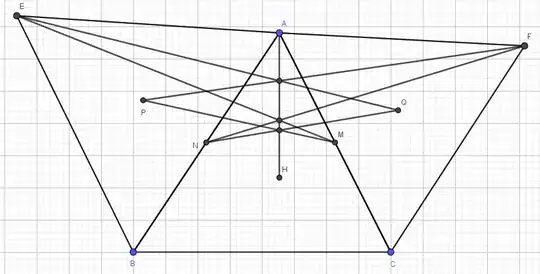This is a very nice problem!
Lemma
Consider the following diagram, where we construct right triangles externally to an arbitrary triangle $\bigtriangleup ABC$. If $\;\measuredangle ABD=\measuredangle CBE \;$ and $\; BG \perp AC$; $$DC, BG, EA$$ are concurrent.

Proof.
Apply the law of sines on $\bigtriangleup CAD$ and $\bigtriangleup CBD$:
$$\frac{CD}{\sin(90°+\alpha+\beta)}=\frac{AD}{\sin \zeta} \tag{1}$$
$$\frac{CD}{\sin(\measuredangle ABD+\gamma+\delta)}=\frac{AD/(\sin\measuredangle ABD)}{\sin \epsilon} \tag{2}$$
Dividing $(1)$ by $(2)$:
$$\frac{\sin(\measuredangle ABD+\gamma+\delta)}{\sin(90°+\alpha+\beta)}=\frac{\sin \epsilon \cdot (\sin\measuredangle ABD)}{\sin \zeta} \tag{3}$$
Applying the law of sines on $\bigtriangleup ACE$ and $\bigtriangleup ABE$ we also get:
$$\frac{\sin(\measuredangle CBE+\gamma+\delta)}{\sin(90°+\epsilon+\zeta)}=\frac{\sin \beta \cdot (\sin\measuredangle CBE)}{\sin \alpha} \tag{4}$$
Since $\bigtriangleup ABG$ and $\bigtriangleup CBG$ are right triangles:
$$\sin\gamma=\sin(\alpha+\beta) \;\; \text{and} \; \sin\delta=\sin(\epsilon+\zeta)\tag{5}$$
Dividing $(3)$ by $(4)$ and substituting from $(5)$:
$$\frac{\sin(\alpha)}{\sin(\beta)}×\frac{\sin(\gamma)}{\sin(\delta)}×\frac{\sin(\epsilon)}{\sin(\zeta)}= 1$$
Hence, by (Trigonometric) Ceva's theorem, the lines are concurrent. We note that this concurrency is independent of the measures of the angles $\measuredangle ABD$ and $\measuredangle CBE$ as long as they are equal.
Back to the original figure,

By the reverse of Thales' Theorem $NM \parallel BC$, so $AH \perp NM$. Construct the line segments $MP, AP, NQ, AQ\;$ and we get the desired configuration for our lemma (the main triangle being $\bigtriangleup AMN$). So, $MP, NQ, AH$ are concurrent. By similar constructions and using our lemma again both $EM, FN, AH$ and $EQ, FP, AH$ are also concurrent. $\; \blacksquare$
I suspect there is a simpler way to prove the Lemma (might be related to Jacobi's Theorem).



